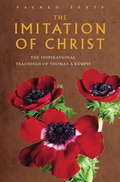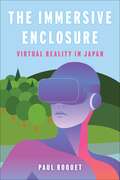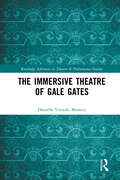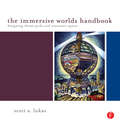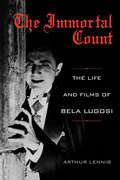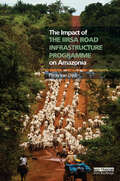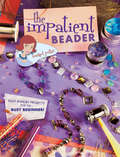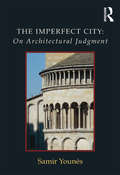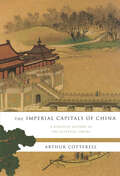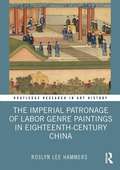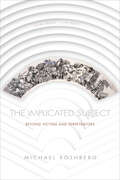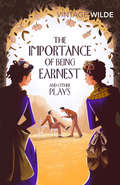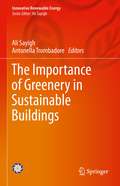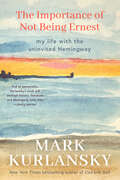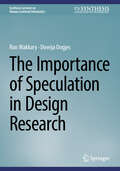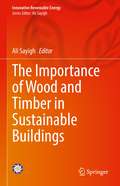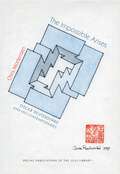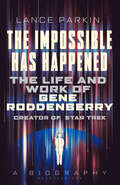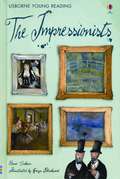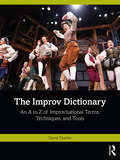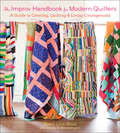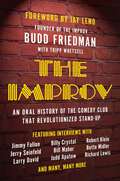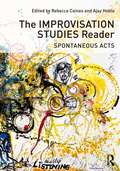- Table View
- List View
The Imitation of Christ
by Stephan MackennaThe saintly Thomas à Kempis's classic guide to the spiritual and religious life. A book which has been loved and revered by devout Christians throughout the ages. Transcending all sectarian divisions, it emphasises the importance of the inward journey.
The Immersive Enclosure: Virtual Reality in Japan
by Paul RoquetAlthough virtual reality promises to immerse a person in another world, its true power lies in its ability to sever a person’s spatial situatedness in this one. This is especially clear in Japan, where the VR headset has been embraced as a way to block off existing social environments and reroute perception into more malleable virtual platforms. Is immersion just another name for enclosure?In this groundbreaking analysis of virtual reality, Paul Roquet uncovers how the technology is reshaping the politics of labor, gender, home, and nation. He examines how VR in Japan diverged from American militarism and techno-utopian visions and became a tool for renegotiating personal space. Individuals turned to the VR headset to immerse themselves in three-dimensional worlds drawn from manga, video games, and genre literature. The Japanese government promised VR-operated robots would enable a new era of remote work, targeting those who could not otherwise leave home. Middle-aged men and corporate brands used VR to reimagine themselves through the virtual bodies of anime-styled teenage girls. At a time when digital platforms continue to encroach on everyday life, The Immersive Enclosure takes a critical look at these attempts to jettison existing social realities and offers a bold new approach for understanding the media environments to come.
The Immersive Theatre of GAle GAtes (Routledge Advances in Theatre & Performance Studies)
by Daniella Vinitski MooneyThis book focuses on experimental theatre company, GAle GAtes, credited as "the true innovator" of the contemporary immersive movement. The Immersive Theatre of GAle GAtes is a case-study of this little-known but visionary company, with a focus on its development and dramaturgy. Through rare archival and primary research, as well as historical context, the text chronicles company narrative and celebrates the artistic impulse. The book employs descriptive-narrative and dramaturgical analysis and is composed of historical research, rare archives, and primary source interviews. Chapters focus on the trajectory of the avant-garde leading up to the climate in which the company formed, company formative years, and major works and a discussion on the interdisciplinary and theoretical frameworks critical to its understanding. This study will be of great interest to students and scholars in theatre and performance studies and essential reading for theatre artist and historian alike, with a focus on the experimental theatre landscape.
The Immersive Worlds Handbook: Designing Theme Parks and Consumer Spaces
by Scott LukasScott Lukas, famed industry expert on designing themed spaces, brings you a book that focuses on the imaginative world of themed, immersive and consumer spaces. Whether or not you are involved in designing a theme park, cultural museum, shop, or other entertainment space, you will benefit from the insider tips, experiences, and techniques highlighted in this practical guide. Make your themed spaces come to life and become true, immersive worlds. The book features informative sidebars addressing possible design issues and current trends; case studies and interviews with real-world designers, and further reading suggestions. The book also includes a companion website, as well as exercises that accompany each chapter, lavish photos, illustrations, and tables.
The Immortal Count: The Life and Films of Bela Lugosi
by Arthur LennigThis definitive biography of the silver screen legend is &“a moving, lively, witty, sad book that revives once more the long dead Count Dracula&” (Kirkus Reviews). Bela Lugosi won immediate fame for his starring role in the 1931 film Dracula—the role that would forever define his persona. After a decade of trying to broaden his range, Lugosi resigned himself to a career as the world's most recognizable vampire, often playing opposite his horror film rival Boris Karloff. When he died in 1956, Lugosi could not have known that vindication of his talent would come—his face would adorn theaters and his Hungarian accent would be instantly recognized across the globe. In 1974, silent film expert Arthur Lennig published The Count, a highly regarded biography of the unsung actor. Now Lennig returns to his subject with a completely revised volume more than twice the length of the original. The Immortal Count provides deeper insights into Lugosi's films and personality. Drawing upon personal interviews, studio memos, shooting scripts, research in Romania and Hungary, and his own recollections, Lennig has written the definitive account of Lugosi's tragic life.
The Impact of the IIRSA Road Infrastructure Programme on Amazonia
by Pitou van DijckThis book analyses the potential socio-economic and environmental impacts of the Initiative for Regional Infrastructure Integration in South America (IIRSA), a continent-wide programme. IIRSA aims at facilitating intra-regional trade and at improving trade and transport links with world markets. This is the first book on IIRSA and its potential implications for South America and more specifically for Amazonia. The book provides an in-depth analysis of the infrastructure programme and deals particularly with methods to assess the probable effects of road construction in environmentally fragile territories. To deepen our understanding of the potential impacts of roads in these areas, the book combines insights from economic and environmental sciences and gives a critical review of traditional assessments and strategic environmental assessments (SEAs). A comprehensive approach of assessing impacts is presented in three case studies of SEAs: the Corredor Norte in Bolivia, the road between Manaus and Porto Velho in Brazil, and the proposed road to link Suriname with Brazil.
The Impatient Beader: Easy Jewelry Projects For The Busy Beginner! (Impatient Beader Ser.)
by Margot PotterGet your bead groove on with The Impatient Beader and you'll be a beading goddess in no time!Do you get antsy waiting for water to boil? Do you feel like it takes ages for fingernail polish to dry? If you're a creative individual who wants to make snazzy jewelry in less time than it takes to clean the kitchen and with the amount of focus required for a movie marathon, you have come to the right place. Greetings and welcome to the wonderful world of beading for the patience impaired. The Impatient Beader gives you over 40 projects plus variations that you can whip up to wear, gift or display in only an hour or two - how's that for almost instant gratification?Grab some beads, and The Impatient Beader will supply the know-how you need to make saucy necklaces, bracelets and earrings that make you stand out in a crowd.Inside you'll find:An extensive step-by-step techniques guide that shows you everything you'll need to know to create all of the projects in the bookA huge selection of gorgeous, one-of-a-kind jewelry pieces from sassy - like the Victorian Temptress Choker - to sweet - like the Sea Dreamer Wrap NecklaceAn easy-to-follow skill level guide that tells you whether a project calls for the skills of a "Beading Virgin," a "Beading Vixen," or a "Beading Goddess"Patience Booster tips and Designer Tips to help make your beading go smoothly and to encourage you to experiment with making your own designsThe Impatient Beader gives you everything you need to start making stylish beaded jewelry pieces right now! What are you waiting for? Go, Bead Queen, go!
The Imperfect City: On Architectural Judgment
by Samir YounesIf architectural judgment were a city, a city of ideas and forms, then it is a very imperfect city. When architects judge the success or failure of a building, the range of ways and criteria which can be used for this evaluation causes many contentious and discordant arguments. Proposing that the increase in number and intensity of such arguments threatens to destabilize the very grounds upon which judgment is supposed to rest, this book examines architectural judgment in its historical, cultural, political, and psychological dimensions and their convergence on that most expressive part of architecture, namely: architectural character. It stresses the value of reasoned judgment in justifying architectural form -a judgment based on three sets of criteria: those criteria that are external to architecture, those that are internal to architecture, and those that pertain to the psychology of the architect as image-maker. External criteria include, philosophies of history or theories of modernity; internal criteria include architectural character and architectural composition; while the psychological criteria pertain to 'mimetic rivalry', or rivaling desires for the same architectural forms. Yet, although architectural conflicts can adversely influence judgment, they can at the same time, contribute to the advancement of architectural culture.
The Imperial Capitals of China: A Dynastic History of the Celestial Empire
by Arthur CotterellFrom the First Emperor's obsessive u and fatal u attempts to engage the Immortals in 219u210 BC, to the striking creativity that produced the golden age of literature and art in Tang Chang'an, to the culmination of architectural virtuosity seen in The Forbidden City of Yong Lee's Beijing in the fifteenth century, this absorbing new book offers a panoramic sweep of an empire that lasted over two millennia through the imperial cities that were the very foundations of each dynasty. Using original Chinese sources and eye-witness accounts, Arthur Cotterell provides an inside view of the rich array of characters, political and ideological tensions, and technological genius that defined the imperial cities of China, as each in turn is revealed, explored, and celebrated. The oldest continuous civilization in existence today stands to become the most influential, its economy expected to exceed that of the United States by 2020. From the cosmological foundations of the first capital to the politics of empire and cataclysmic civil wars, IMPERIAL CITIES OF CHINA offers a level of insight indispensable for a true understanding of China today.
The Imperial Patronage of Labor Genre Paintings in Eighteenth-Century China (Routledge Research in Art History)
by Roslyn Lee HammersThis book examines the agrarian labor genre paintings based on the Pictures of Tilling and Weaving that were commissioned by successive Chinese emperors. Furthermore, this book analyzes the genre’s imagery as well as the poems in their historical context and explains how the paintings contributed to distinctively cosmopolitan Qing imagery that also drew upon European visual styles. Roslyn Lee Hammers contends that technologically-informed imagery was not merely didactic imagery to teach viewers how to grow rice or produce silk. The Qing emperors invested in paintings of labor to substantiate the permanence of the dynasty and to promote the well-being of the people under Manchu governance. The book includes English translations of the poems of the Pictures of Tilling and Weaving as well as other documents that have not been brought together in translation. The book will be of interest to scholars working in art history, Chinese history, Chinese studies, history of science and technology, book history, labor history, and Qing history.
The Implicated Subject: Beyond Victims and Perpetrators (Cultural Memory in the Present)
by Michael RothbergWhen it comes to historical violence and contemporary inequality, none of us are completely innocent. We may not be direct agents of harm, but we may still contribute to, inhabit, or benefit from regimes of domination that we neither set up nor control. Arguing that the familiar categories of victim, perpetrator, and bystander do not adequately account for our connection to injustices past and present, Michael Rothberg offers a new theory of political responsibility through the figure of the implicated subject. The Implicated Subject builds on the comparative, transnational framework of Rothberg's influential work on memory to engage in reflection and analysis of cultural texts, archives, and activist movements from such contested zones as transitional South Africa, contemporary Israel/Palestine, post-Holocaust Europe, and a transatlantic realm marked by the afterlives of slavery. As these diverse sites of inquiry indicate, the processes and histories illuminated by implicated subjectivity are legion in our interconnected world. An array of globally prominent artists, writers, and thinkers—from William Kentridge, Hito Steyerl, and Jamaica Kincaid, to Hannah Arendt, Primo Levi, Judith Butler, and the Combahee River Collective—speak to this interconnection and show how confronting our own implication in difficult histories can lead to new forms of internationalism and long-distance solidarity.
The Importance of Being Earnest and Other Plays
by Oscar WildeA selection of Oscar Wilde's best and most important plays - sharp, relevant and brilliant to this day. Who would have thought a comedy of manners written more than a hundred years ago would still be so apt and so funny? Oscar Wilde was a genius of play-writing, and his deftness, wit and sharp eye for social satire keep audiences in thrall to this day. Alongside Earnest, discover a biblical tragedy retold, Lady Windemere and her infamous fan and Wilde's take on an ideal husband, in this selection of Wilde's most important plays. ‘[The Importance of Being Earnest] has a strong claim to being the most perfect comedy in the English language’ Daily Telegraph
The Importance of Greenery in Sustainable Buildings (Innovative Renewable Energy)
by Ali Sayigh Antonella TrombadoreThis book covers the important aspects of greenery in buildings, both in the landscape and within buildings, examining how greenery improves comfort and appeal in sustainable buildings. The book is part of the World Renewable Energy Network’s drive to encourage architects and builders to use greenery as much as possible in their design to reduce energy consumption and provide a pleasant appearance and pleasing aspect to their buildings. It shows and demonstrates how widespread the use of greenery is in buildings, and the books 17 chapters were chosen from 12 different countries representing a truly global look at the use and benefit of using greenery in buildings. This book is aimed at architects, building construction authorities, urban planners, and policymakers to encourage the use of greenery in their future buildings and explain why it is important to do so.
The Importance of Not Being Ernest: My Life with the Uninvited Hemingway
by Mark KurlanskyThe New York Times–bestselling author of Salt examines the intersections between his life and Ernest Hemingway’s in this mix of travel memoir and history.By a series of coincidences, Mark Kurlansky’s life has always been intertwined with Ernest Hemingway’s legend, starting with being in Idaho the day of Hemingway’s death. The Importance of Not Being Ernest explores the intersections between Hemingway’s and Kurlansky’s lives, resulting in creative accounts of two inspiring writing careers. Travel the world with Mark Kurlansky and Ernest Hemingway in this personal memoir, where Kurlansky details his ten years in Paris and his time as a journalist in Spain—both cities important to Hemingway’s adventurous life and prolific writing.Paris, Basque Country, Havana and Idaho.Get to know the extraordinary people he met there—those who had also fallen under the Hemingway spell, including a Vietnam veteran suffering from the same syndrome the author did, two winners of the Key West Hemingway look-alike contest, and the man in Idaho who took Hemingway hunting and fishing.In The Importance of Not Being Ernest, find:A memoir full of entertaining and illuminative storiesLittle-known historical facts about Hemingway’s lifeAnecdotes about those who suffer from what the Kurlansky calls “hemitis”Readers of Haruki Murakami’s What I Talk About When I Talk About Running, John Steinbeck’s Travels with Charley in Search of America, or The Boys will love The Importance of Not Being Ernest.Praise for The Importance of Not Being Ernest“An absolute delight! Full of personality, Kurlansky’s book will enchant history, literature, and Hemingway fans alike.” —Library Journal (starred review)
The Importance of Speculation in Design Research (Synthesis Lectures on Human-Centered Informatics)
by Ron Wakkary Doenja OogjesThis book explores speculation in design research in the field of human-computer interaction (HCI). The authors reveal how speculative reasoning in design research increases the capacity of HCI to address a wider array of social and research challenges. Speculation in design research employs (1) leaps of imagination, (2) diverse ways of knowing or epistemologies, (3) ethical reflexivity, (4) and makes alternate possibilities experiential. This book shows how each can be productively and critically applied together through existing, emerging, and new research approaches in HCI. The aim of this book is to generously see speculation as more than a form of critique or genre of design research, to instead be seen as broadly central to the material investigations that govern much of the field. In doing so, the book aims to expand the potential role of speculation in HCI and shows how speculation is applicable to a wide range of research goals, which, in turn, creates research approaches in new directions. In expanding the approach and methodology of speculation in HCI, the books draw inspiration from other disciplines and intersectional perspectives. By examining current, emerging, and possible new forms of speculation methods, this book will be of interest to undergraduate and graduate students in HCI as well as seasoned researchers and practitioners.
The Importance of Wood and Timber in Sustainable Buildings (Innovative Renewable Energy)
by Ali SayighThis book emphasizes the important message that architects and structural engineers must strive to ensure that the buildings they design and construct should not be major contributors to climate change. Rather, they should be exploring the use of green materials and building methods – such as timber, wood, and associated materials – in order to safeguard the environment. These sustainable materials are not only environmentally friendly, but they have the added benefit of being easy to manufacture, cost effective, often locally available, and easily replenished. Moreover, it has been demonstrated that wood and timber are viable materials in the construction of a wide variety of building types, including medium and high-rise buildings.The Importance of Wood and Timber in Sustainable Buildings brings together a distinguished group of contributors from different cultures and building traditions to address why now is the time to rethink our construction methods and explore replacing many of the carbon intensive materials that are currently being used with wood and timber.
The Impossible Arises: Oscar Reutersvärd and His Contemporaries (Special Publications of the Lilly Library)
by Chris MortensenThe Impossible Arises explores the life and work of Oscar Reutersvärd (1916–2002), founder of the Impossible Figures movement. The movement began in Stockholm in 1934 when eighteen-year-old Reutersvärd drew the first impossible triangle. Over the course of his life he would go on to draw around 4000 impossible figures and be honored by the Swedish government with an issue of stamps showing his work. Based on a large collection of Reutersvärd's art and correspondence held at the Lilly Library at Indiana University Bloomington, the lavishly illustrated Impossible Arises examines the evolution of Reutersvärd's impossible figures and how they influenced other modern artists in the later twentieth century. The Impossible Arises offers a detailed look at the philosophy guiding Reutersvärd's art and presents a rich array of stories from his eccentric personal life. It is an essential introduction to the life and career of one of the most fascinating artists of the twentieth century.
The Impossible Has Happened: The Life and Work of Gene Roddenberry, Creator of Star Trek
by Lance ParkinA biographer goes in search of Gene Roddenberry, creator of the world’s most successful science fiction franchise.This book reveals how an undistinguished writer of cop shows set out to produce “Hornblower in space” —and ended up with Star Trek, an optimistic, almost utopian view of humanity’s future that has been watched and loved by hundreds of millions of people around the world.Along the way, Lance Parkin examines some of the great myths and turning points in the franchise’s history, and Roddenberry’s particular contribution to them. He looks at the view that the early Star Trek advanced a liberal, egalitarian, and multi-racial agenda; charts the various attempts to resuscitate the show during its wilderness years in the 1970s; explores Roddenberry’s initial early involvement in the movies and spin-off Star Trek: The Next Generation (as well as his later estrangement from both), and sheds light on the colorful personal life, self-mythologizing, and strange beliefs of a man who nonetheless gifted popular culture one if its most enduring narratives.
The Impressionists
by Rosie DickinsToday Impressionist paintings draw huge crowds and sell for millions. But when they were first painted, those same pictures caused public outrage and the artists who created them struggled to make a living. This is the fascinating story of those artists, now known as the Impressionists.
The Impressionists at First Hand (World of Art #0)
by Bernard DenvirAn updated edition of this classic collection of letters, critical reviews, and reminiscences by impressionist artists and their contemporaries. The impressionists—Claude Monet, Édouard Manet, Edgar Degas, Berthe Morisot, Camille Pissarro, Pierre-Auguste Renoir, Alfred Sisley, and others—are probably the most popular of all artistic schools. Their struggle to impose a new vision is one of the most absorbing stories in the whole history of art. With imagination and insight, art historian Bernard Denvir brings impressionism into focus by showing it through the eyes of the artists themselves and their contemporaries, against the background of the time. Through letters, critical reviews, statements, and reminiscences of the people who were there, the story of this groundbreaking art movement comes alive. This was the age of innovation, political liberalization, emergent photography, and modern ideas about perception. The impressionists had new ways of painting, but they also had a new world to paint. This revised edition now features full-color reproductions of art throughout and an updated bibliography.
The Improv Dictionary: An A to Z of Improvisational Terms, Techniques, and Tools
by David CharlesThe Improv Dictionary: An A to Z of Improvisational Terms, Techniques, and Tools explores improvisational approaches and concepts drawn from a multitude of movements and schools of thought to enhance spontaneous and collaborative creativity.This accessible resource reveals and interrogates the inherited wisdoms contained in the very words we use to describe modern improv. Each detailed definition goes beyond the obvious clichés and seeks a nuanced and inclusive understanding of how art of the moment can be much more than easy laughs and cheap gags (even when it is being delightfully irreverent and wildly funny). This encyclopedic work pulls from a wide array of practitioners and practices, finding tensions and commonalities from styles as diverse as Theatresports, Comedysportz, the Harold, narrative long-form, Playback Theatre, and Boal’s Theatre of the Oppressed. Entries include nuanced definitions, helpful examples, detailed explorations of the concepts in practice, and framing quotes from a leading practitioner or inspirational artistic voice.The Improv Dictionary offers valuable insights to novice improvisers taking their first steps in the craft, seasoned performers seeking to unlock the next level of abandon, instructors craving a new comprehensive resource, and scholars working in one of the numerous allied fields that find enrichment through collaborative and guided play.Each significant entry in the book is also keyed to an accompanying improv game or exercise housed at www.improvdr.com, enabling readers to dig deeper into their process.
The Improv Handbook for Modern Quilters: A Guide to Creating, Quilting & Living Courageously
by Sherri Lynn WoodAn exciting new approach for beginning to advanced quilters who want to improvise on their own, with a friend, or with a community of fellow makers.Forget step-by-step instructions and copycat designs. In The Improv Handbook for Modern Quilters, Sherri Lynn Wood presents a flexible approach to quilting that breaks free of old paradigms. Instead of traditional instructions, she presents 10 frameworks (or scores) that create a guiding, but not limiting, structure. To help quilters gain confidence, Wood also offers detailed lessons for stitching techniques key to improvisation, design and spontaneity exercises, and lessons on color. Every quilt made from one of Wood’s scores will have common threads, but each one will look different because it reflects the maker’s unique interpretation. Featured throughout the book are Wood’s own quilts and a gallery of contributor works chosen from among the hundreds submitted when she invited volunteers to test her scores during the making of this groundbreaking work.“Wood offers a series of techniques, guidelines and lessons on color choice for those ready to explore improvisational quilting. Her book is loaded with full-color photos and examples to inspire.” —Dallas Morning News“Despite how it may “seam,” quilting isn’t all about rules! Quilting can be an exhilarating way to channel your creativity and express yourself. This book is focused more on exploration than explanation—a perfect mindset for beginners!” —Powell’s Books Staff Pick
The Improv: An Oral History of the Comedy Club that Revolutionized Stand-Up
by Budd Friedman Tripp WhetsellFeatured in the New York Times 2017 "Holiday Gift Guide for Hardcover Fans" Get an insider's oral history of the World's most iconic comedy club, featuring exclusive interviews with today's most hilarious stars recalling their time on stage (and off) at the Improv. In 1963, 30-year-old Budd Friedman—who had recently quit his job as a Boston advertising executive and returned to New York to become a theatrical producer—opened a coffee house for Broadway performers called the Improvisation. Later shortened to the Improv, its first seedy West 44th Street location initially attracted the likes of Judy Garland, Liza Minnelli, Albert Finney, and Jason Robards, as well as a couple of then-unknowns named Dustin Hoffman and Bette Midler. While it drew near-capacity crowds almost from day one, it wasn't until comedians began dropping by to try out new material that the Improv truly hit its stride. The club became the first venue to present live stand-up in a continuous format, and in the process reinvented the art form and created the template for all other comedy clubs that followed. From the microphone to the iconic brick wall, the Improv has been the launching pad for practically every major name in American comedy over the last five-plus decades. Now, in The Improv, Friedman, along with a Who's Who of his most famous alumni—including Jay Leno, Jerry Seinfeld, Jimmy Fallon, Larry David, Billy Crystal, Lily Tomlin, Judd Apatow, Al Franken, Paul Reiser, Howie Mandel, Bob Saget, Drew Carey, and many more—tell it like it was in the first-ever oral history of how this game-changing comedy club came to be. The Improv gives readers an exclusive look at what really happened onstage and off-mic at one of America's most venerable institutions.
The Improvisation Studies Reader: Spontaneous Acts
by Ajay Heble Rebecca CainesImprovisation is a performance practice that animates and activates diverse energies of inspiration, critique, and invention. In recent years it has coalesced into an exciting and innovative new field of interdisciplinary scholarly inquiry, becoming a cornerstone of both practical and theoretical approaches to performance. The Improvisation Studies Reader draws together the works of key artists and thinkers from a range of disciplines, including theatre, music, literature, film, and dance. Divided by keywords into eight sections, this book bridges the gaps between these fields. The book includes case studies, exercises, graphic scores and poems in order to produce a teaching and research resource that identifies central themes in improvisation studies. The sections include: Listening Trust/Risk Flow Dissonance Responsibility Liveness Surprise Hope Each section of the Reader is introduced by a newly commissioned think piece by a key figure in the field, which opens up research questions reflecting on the keyword in question. By placing key theoretical and classic texts in conversation with cutting-edge research and artists’ statements, this book answers the urgent questions facing improvising artists and theorists in the mediatized Twenty-First Century.
The Inclusive Housing Design Guide
by Habinteg Housing AssociationThe Inclusive Housing Design Guide is a revised and updated edition of the seminal Habinteg Housing Design Guide first published in 2002. The guide provides a brief and advice for all those involved in the design and delivery of Habinteg developments, informing new build technical standards and employers' requirements for accessible homes.This new guide takes into account updated reference standards, specifically addressing M4(2) and M4(3) of UK building regulations. The proposed guide will provide the rationale for, specifications and technical guidance on how to deliver accessible and inclusive housing that is flexible and adaptable to changing needs.With invaluable advice, insights, explanations and illustrations, it is an essential guide on how to deliver housing that is functional, inclusive and meets the changing needs of people of all ages.
